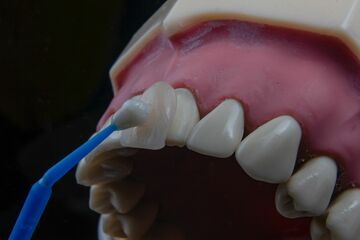
For anyone looking for an instant smile makeover, veneers can offer incredible results. While this treatment was once considered to be reserved for the rich and famous, it is becoming increasingly more accessible thanks to advances in materials and techniques.
A veneer is a thin shell of porcelain or ceramic which fits over the front of the teeth. This allows the dentist to achieve a complete smile makeover by covering the “social six”. These are the top front teeth that are visible when you smile. By focusing on these teeth, the dentist can achieve a complete smile transformation that doesn’t require orthodontics or teeth whitening.
In this guide, we’re going to look at the role of veneers in modern cosmetic dentistry and how they can be used to achieve a wide range of results.
Types of veneers
Veneers are typically made from hard, tooth-coloured materials such as porcelain or ceramic. In recent years, dentists are increasingly using composite resin materials to achieve incredible results.
Some materials look more like natural teeth than others. Porcelain offers the most realistic solution, as the material offers a similar shine and transparency level to natural tooth material. Porcelain is a strong material, but it is prone to chips and cracks.
Porcelain also happens to be the priciest choice, so if you’re on a budget, you might consider composite veneers as a cheaper alternative.

When are they used?
Veneers provide an instant smile makeover. They are commonly used for aesthetic reasons, but they can also be restorative. If you have missing teeth, a veneer can also act as a bridge to hide the gap in your smile and restore your bite.
Veneers can also be used in place of orthodontics to help achieve the appearance of a straighter smile. If there is discolouration that cannot be addressed with teeth whitening, then veneers offer a perfect solution.
Veneers are also great for ageing smiles. If you have thinning enamel or multiple imperfections such as chips and cracks, then veneers can help restore your smile and help you to feel more youthful.

Advantages of veneers
There are many advantages to veneers, including:
They offer instant results without the need to wait for treatments like orthodontics. The treatment will typically be completed in 2 – 3 trips to the dentist.
There is a wide range of materials available to ensure veneers are available for all budgets. If you don’t have the budget for porcelain veneers right now, you could opt for composite veneers and then upgrade them in 5 years’ time when your composite veneers start to wear down.
Veneers can address a number of aesthetic imperfections at once. This could include things like misalignments, chips, cracks, gaps and discolouration.
Composite veneers are incredibly cost-effective and make this type of treatment affordable to more people. They are also incredibly quick and can be completed in just one visit.

Disadvantages of veneers
While this treatment might be suitable for a lot of patients, it might not be right for everyone. These are just some of the disadvantages of the treatment that you should consider before moving forward.
Veneers won’t last forever. Eventually, you will need to repair or replace the unit. Since the underlying tooth material has to be prepared before the porcelain or ceramic veneer is placed, this makes it a permanent restoration. This means you will always need to have a veneer in place.
Veneers are prone to chips and cracks, usually more so than natural teeth. The wearer will need to consider their choices and avoid habits like chewing ice, using their teeth to open packages, and biting directly into very hard foods like crusty bread.
Quality veneers can be very expensive. Thankfully, composite veneers offer a cheaper alternative, but these won’t look as natural as porcelain veneers, so there is a clear trade-off in quality.
The future of veneers
We should see an increase in the use of composite materials in veneers and this will help to make treatment cheaper, faster and more accessible. Composite materials are improving all the time and becoming stronger and more durable.
With more dentists investing in lab-quality tools for their practice, we should also see an increase in the number of dentists offering veneers that are designed and created under one roof, without the need to send the designs to a third-party lab to be created. This will reduce costs and also reduce waiting times for patients.
While veneers might not be right for everyone, as the treatment changes, we could see it becoming a more mainstream treatment option for smile makeovers.
Contact us to make an appointment
Exclusive Offer
Airflow stain removal from our hygienist


Composite Bonding – Is it a Good Idea?
22.11.2023

Teeth Straightening – is it for you?
12.08.2016
Time for you perfect smile?
Book your consultation today
When visiting our practice you know you are visiting the dental professionals trained to the highest standards. You are greeted by our welcoming staff, who share the same aim, to make your visit with us as comfortable and stress free as possible.





